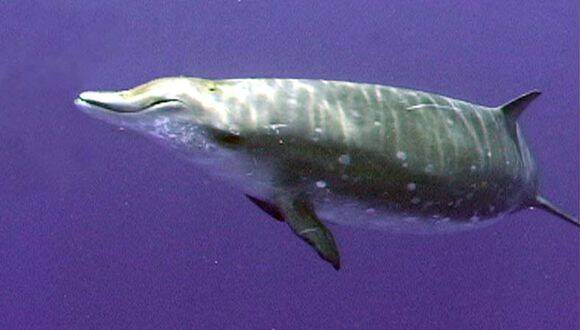Hyperoodon planifrons
IUCN
LCBasic Information
Scientific classification
- name:Hyperoodon planifrons
- Scientific Name:
- Outline:Cetacea
- Family:B.whales D.whales
Vital signs
- length:6-7.5m
- Weight:6-8 tons
- lifetime:No verification information
Feature
The dorsal fin is located at the back 2/3 of the back, the forehead is convex and the beak is prominent.
Distribution and Habitat
Widely distributed than the northern bottlenose whale, with records from the entire southern hemisphere waters north of Antarctica to 30 degrees south latitude. Other possible sightings include southern Japan, near Hawaii, and along the equatorial Pacific and Indian Oceans, but none of them have been confirmed; they may be different populations of this species. Most common on the edge of the continental shelf and above submarine canyons, in waters over 1000 meters. Rarely seen in waters less than 200 meters deep. Most common within 100 kilometers of the edge of Antarctic icebergs in summer, which also seems to be a fairly common distribution area.
Appearance
The color of the forehead and small beak is lighter than other parts. The wide blow hole is located in the recess and the end is slightly curved. The caudal fin is slightly hook-shaped or triangular. The upper part of the upper jaw is sunken. The small pectoral fin gradually shrinks toward the end. The end is sharp. The body There are often abrasions and scars, the abdomen is mottled milky brown or off-white, and the body is solid cylindrical.
Before diving deeply, the tail fin may be lifted out of the water. The tail fin has no indentation. The trailing edge of the wide tail fin is concave inward and is uniformly brown or gray.
The teeth on the top of the male's jawbone are protruding and exposed. The head of an immature female. The color of the calf whale is darker, and the forehead ridges of the calf and male whales are less obvious.
Information on the Southern Bottlenose Whale is extremely limited, and it is rarely seen at sea. They live in waters far away from shippi
Details
The scientific name of the Southern Bottlenose Whale is Hyperoodon planifrons, and its foreign name is Southern Bottlenose Whale. It feeds exclusively on squid and cuttlefish. The contents of its stomach are almost entirely cephalopod beak residues. Some squid from the Antarctic and Subantarctic waters are also favorite foods of sperm whales, but the Southern Bottlenose Whale seems to prefer smaller species. It may also include a small amount of fish and invertebrates.

Southern Bottlenose Whales are rarely seen swimming close to ships, but this may be due to a lack of observations rather than their shy nature. After a long dive, they will stay on the surface for 10 minutes or more, blowing air every 30 to 40 seconds. The tree-like air jets are about 1 to 2 meters high, slightly forward, and clearly visible in good weather. They can stay in the water for at least 1 hour, but typical dives are shorter. When swimming fast, especially when threatened, they may lift their heads out of the water as they rise. They may be able to dive very deep, but when diving, they usually do not move horizontally for long distances.
Protect wildlife and stop eating game.
Maintaining ecological balance is everyone's responsibility!








